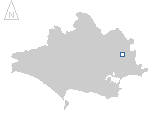
Search:
Holt Heath
Much of the eastern part of the county was once covered with heathland, probably a result of forest clearing during the Bronze Ages. Most has since been turned over to agriculture or forestry, but positive efforts are being made to restore some areas back to their original open and wild condition. Holt Heath – a 488 hectare National Nature Reserve – is one of Dorset's largest remaining areas of lowland heathland. Owned by the National Trust, it is managed by English Nature.

|

|

|

|

|

|

|

|

|

|
|
To view any image full size - simply click on the thumbnail
| ||||
During July and August the colours of the heath are at their most vivid – the striking yellow of the Bog Asphodel (Narthecium ossifragum) contrasting with the purples and pinks of the heather. Whilst close to the ground in wet areas lie the sticky, insect trapping leaves of Sundews (Drosera). Even in mid-summer large tracts remain waterlogged. In days past – i.e. before metalled roads – the heaths had a fearsome reputation for their impassibility.
Find out more ... |
|
In the top row of pictures:
In the bottom row of pictures:
For views of heathland in winter try Canford Heath. See also: Middlebere Heath Nearby locations that also feature in galleries on this site: More views of Dorset in July Other sites on the webThe Countryside Management site of Surrey County Council has an introduction to lowland heath on their 'Heathland > Heathland Basics' page The Dorset Page: Holt – local information and links to further resources on the web Maps of the area on streetmap.co.uk: 1:50,000 – detail, 1:250,000 – locality and route to get there
|